Ceiling: selection criteria for finishing materials
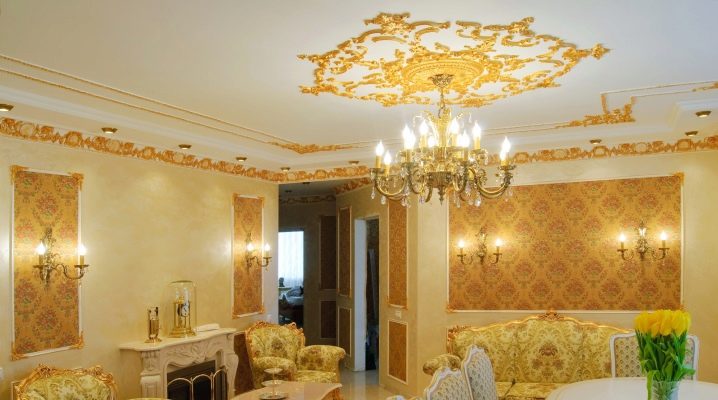
The existing variety of finishing materials and variations in the design of ceilings from the most elementary and affordable to complex and expensive can be confusing. But such an abundance opens up truly endless possibilities for the implementation of any design ideas and allows you to make your dreams come true.
You can become the owner of the ultramodern carved tension structure Apply, an LED panel with a view of space, an up-to-date solution with massive decorative beams, a colorful coffered ceiling in the Renaissance style ... There are a lot of options. Today we will talk about finishing and decorating the ceiling area.
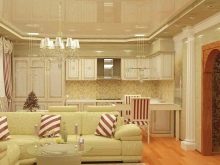

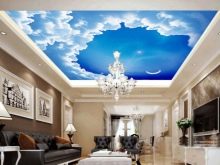
What it is?
Ceiling finishing should be understood as the creation of a protective and decorative layer from various materials on the basis of the ceiling surface. Compared to the floor or walls, finishing the ceiling is much more difficult due to the laboriousness of the work. It is possible to do the roughing and finishing of the ceiling zone only when all vital engineering systems are fully assembled and tested for operability and hidden electrical wiring is installed.
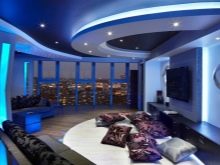
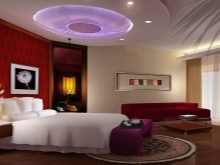
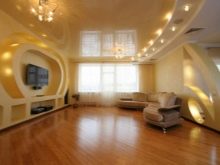
Peculiarities
Modern types of ceilings are classified based on the technology of creation, depending on what they are:
- Plastering (basic). They are obtained by applying a decorative coating on a base base without an air gap by means of traditional "wet" finishing methods - whitewashing, wallpapering, decorating with interior paints, textured plaster mixes or artistic painting.
- Suspended / hemmed in the form of tension suspended, panel, tile, rack, self-adhesive, plasterboard structures. When installing them, "dry" technologies for organizing the ceiling space are used, with the exception of gypsum plasterboard ceilings, which require additional "wet" finishing.
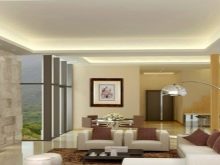
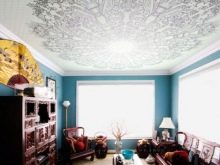

When choosing a ceiling device, you need to take into account:
- Layout type - open, closed or intermediate between them.
- The area and geometry of the premises, especially in attic apartments, where the roofs have broken bases or are located at an angle, and country houses such as chalets with an attic.
- Ceiling height. In apartments with a standard wall height of 2.5 m, planning the design of the ceiling surface must be especially careful so as not to overload the space above your head.
- Humidity mode, which directly depends on the purpose of the room.
- Stylish execution of the room.
- The level of repair - class "Economy", "Comfort" or "Elite". Here they start from the budget possibilities.
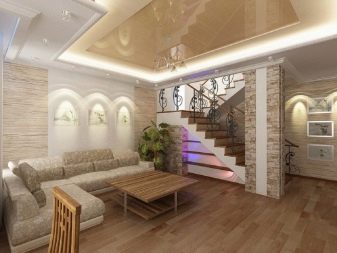
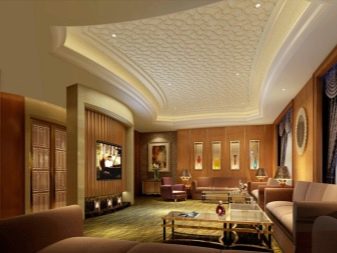
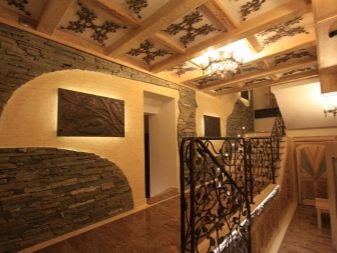
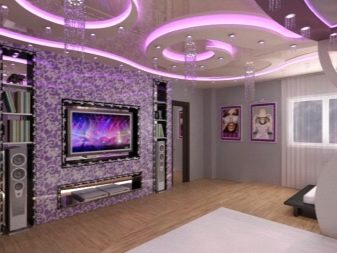
Modern materials
For the decoration of ceiling surfaces, a wide variety of types of finishing materials are used - from traditional ones, which are well known to everyone, to innovative types of liquid wallpaper.
- Interior paints
One of the most optimal solutions for finishing the ceiling area is decorating with water-dispersion paint. This material is a water-based film former, the main component of which is water with the addition of an emulsion of any polymer.

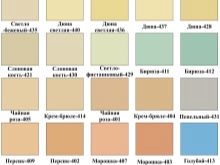

Pros:
- environmentally friendly composition;
- fire safety;
- ease of application with a roller or spray gun;
- good resistance of the coating to mechanical stress due to the compacted polymer film;
- excellent covering ability;
- a rich palette of colors and a huge selection of interesting textures, which allows you to get an expressive design of the ceiling area with a matte or glossy finish.
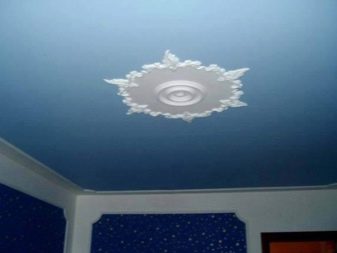

In rooms with high humidity conditions, it is beneficial to purchase moisture-resistant washable paints - latex and silicone.
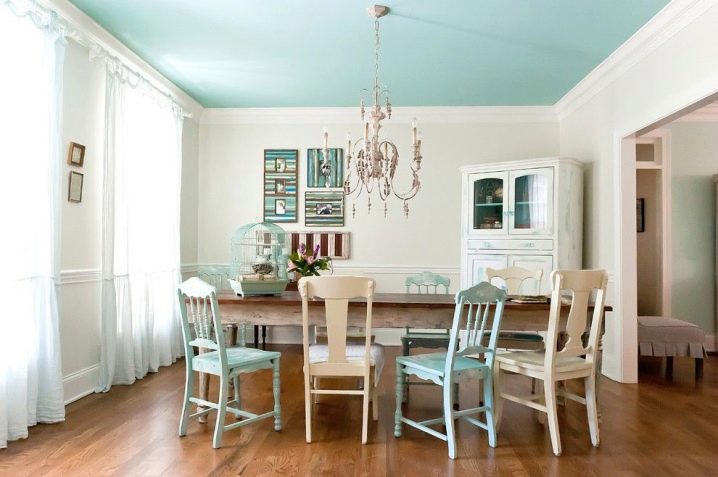
- Textured and structural plaster mixes
Working with structural plaster takes place in three stages - applying a base layer, shaping a relief with a trowel, painting and glazing. After processing the base with textured plaster, the surface immediately acquires a finished relief and a certain shade, with the exception of the application of white mixtures that require additional staining. The type of relief pattern is determined by the filler in the mixture - quartz, granite or marble chips and the size of the particles. Advantages - aesthetics, high-quality masking of base defects, durability and ease of maintenance.
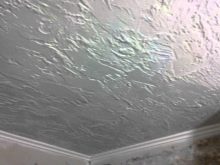
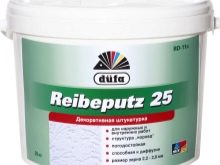

- Wallpaper
Wallpaper-pasted ceilings are still relevant. The widest selection of designs, colors and sizes of canvases offered by domestic and foreign brands makes it easy to choose the right option for interiors of a wide variety of styles - from classic to industrial style.
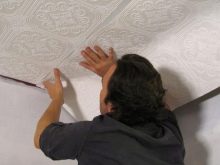

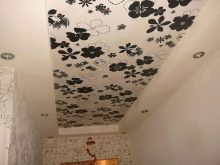
Advantages:
- the ability to hide minor defects in the base with dense coverings or natural wallpaper made of plant fibers;
- paintable wallpaper allows you to change the design of the ceiling without radical transformations;
- canvases with a 3D effect illusoryly adjust the proportions of the ceiling, making it more voluminous due to perspective subjects.
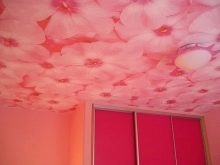

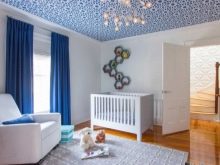
Minuses:
- fragility;
- the need to carefully prepare the base;
- it is almost impossible to glue the wallpaper on a large area alone without involving an assistant.
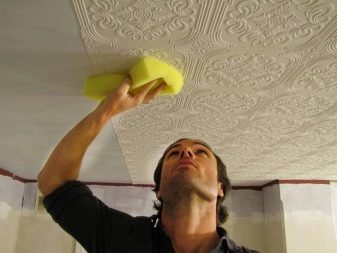
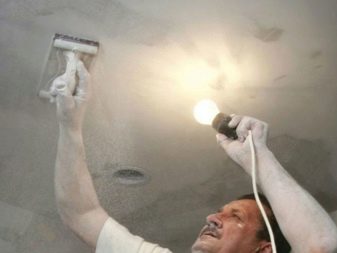
Liquid wallpaper is sold in the form of a powdery mixture based on natural fibers with the addition of acrylic dye and an adhesive component. The main composition can be decorated with crushed mica, stone chips, sparkles and even gold threads.
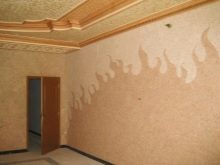
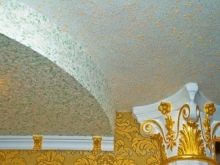
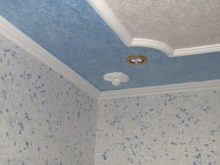
Advantages:
- easy to apply and have good maintainability;
- durable - service life is 8-10 years;
- vapor permeable, which guarantees the creation of a healthy microclimate in the room;
- fireproof - self-extinguish when ignited and prevent the spread of flame;
- seamless;
- using a uniform layer, it is convenient to decorate various volumetric-spatial elements from corners and arches to niches and skirting boards.
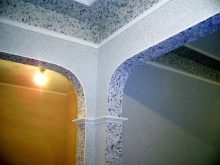
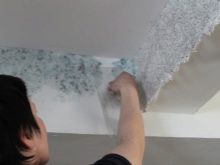
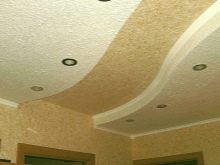
Their main disadvantage is their high cost. Buying a package of liquid silk wallpaper will cost around 650 rubles.
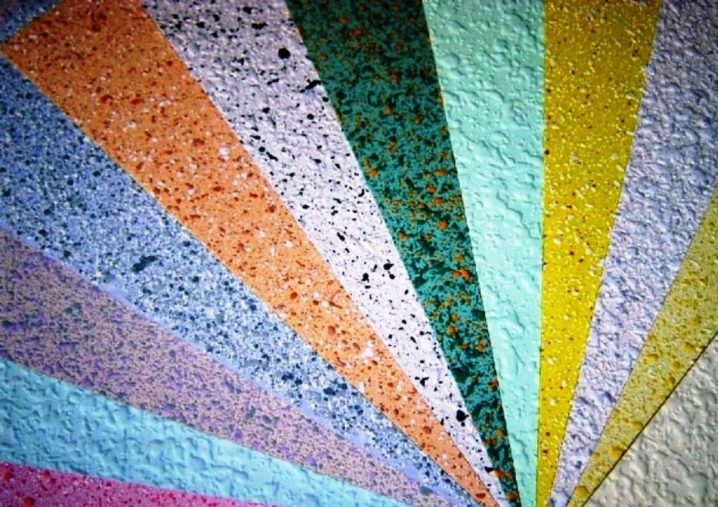
- Ceiling slabs
The popularity of glue ceilings explains two factors. They resort to this method of finishing when they want to get something more than banal whitewashing and wallpapering the ceiling, but are not ready to spend a lot of money. Ceiling tiles fit these criteria. They differ in the material of manufacture. The most common of them are polystyrene foam, polyurethane foam, extruded polystyrene foam. The latter material is the most durable.
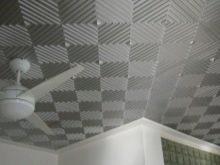
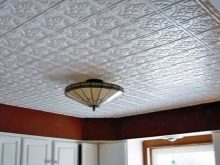
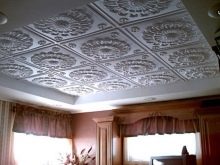
By execution, they can be:
- without / with a pattern;
- in the form of photo wallpaper, when a large image is assembled fragmentarily according to the principle of a puzzle of tiles with parts of a general picture.
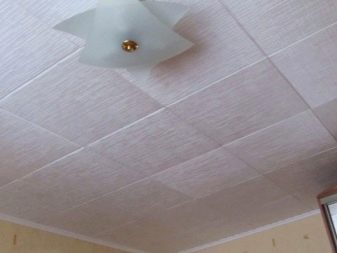
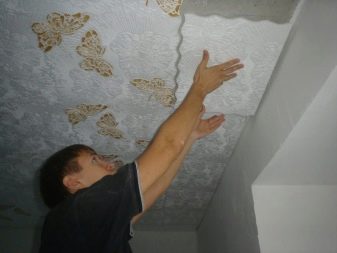
Plates can have different surfaces:
- smooth;
- embossed with various cut patterns;
- with imitation of artistic carving or stucco molding.

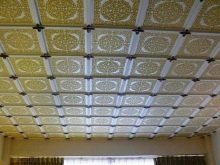
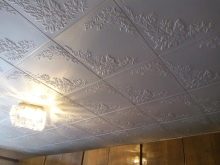
Advantages of glue ceilings:
- universal - suitable for decoration of any premises;
- keep the height of the room;
- mask small local defects of the base;
- are simply mounted.


Disadvantages:
- fire hazardous, and "doubly", since the burning of plates is accompanied by the formation of a fiery "rain";
- form a non-uniform surface with seams;
- susceptible to fungus and mold, with low vapor permeability.
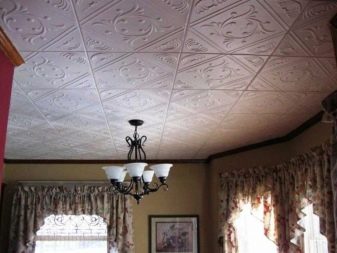
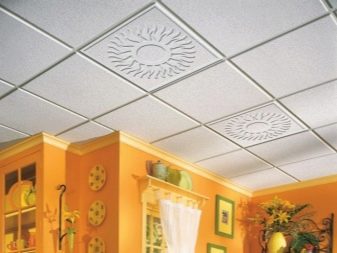
- Textiles
Decorating with fabric is a convenient and simple option for finishing the ceiling area. This design looks original and allows you to improve the acoustics in the room. There are two ways to decorate with textiles.
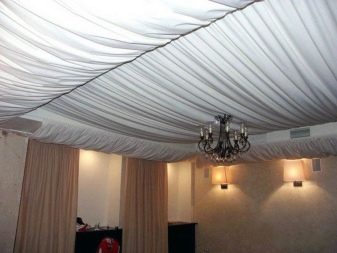
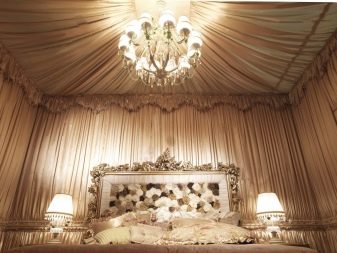
- Pasting. Gluing cloth canvases to the base follows the same principle as wallpaper on a paper base, but on a special adhesive that is harmless to the fibers of the fabric.
Pros:
- aesthetics;
- environmental friendliness;
- promotes proper air exchange in the room due to the breathable properties of the fabric.
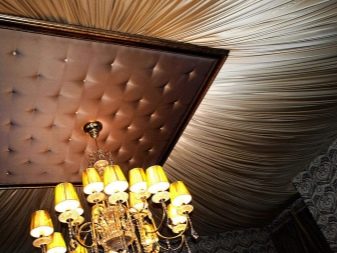
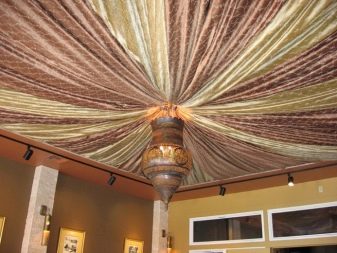
Minuses:
- it is required to level the rough base;
- cannot be removed to clean or wash;
- you need to carefully select the matter and print.
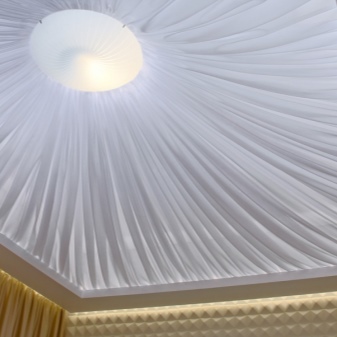
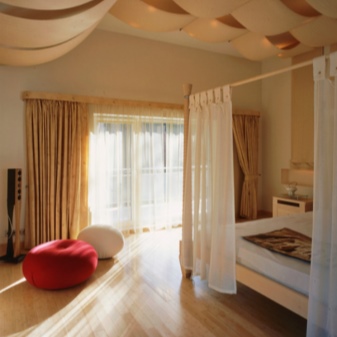
It is good to paste over the ceiling surface with velvet, velor, suede.
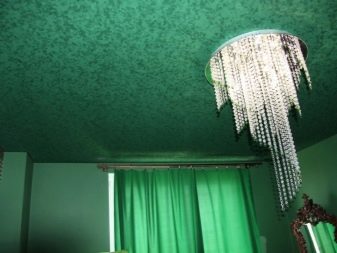
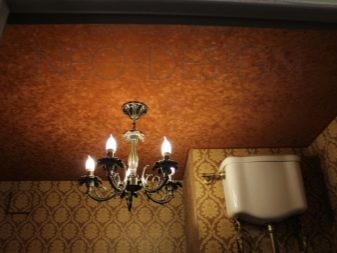
- Stretched fabric ceiling. This option involves stretching the fabric parallel to the ceiling surface like canvas on a wooden frame. Advantages - savings on expensive plastering of the base and the ability to hide its defects due to the tightly stretched fabric. It is best to finish the ceiling with satin and viscose, and you can also use chintz, linen, tapestry, various types of upholstery fabrics.
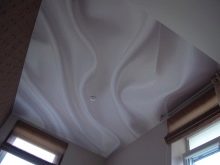

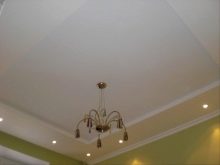
- Drapery
Such a finish involves draping the ceiling area in whole or in individual fragments of the surface. This is a great opportunity to customize your interior.
Methods for fixing draperies:
- on wooden guides with furniture staples;
- using Velcro tape;
- first on the baguette, which is then attached along the closed contour of the ceiling zone.
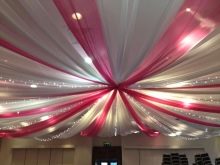
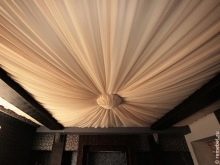
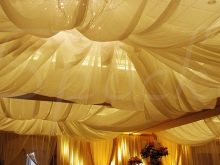
Pros:
- there is no need to prepare the base;
- easy installation;
- easy to keep clean: detach the fabric and wash.

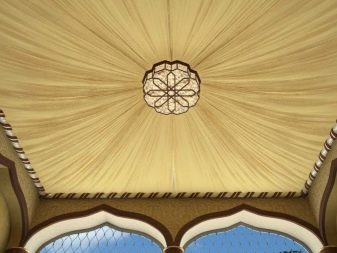
Minuses:
- a strong drop in the level of the ceiling;
- any matter quickly ignites;
- susceptibility of fabric to odors.
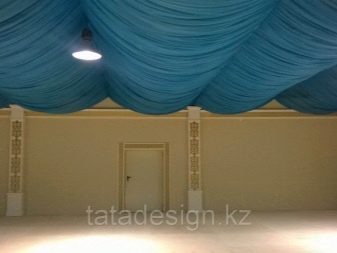
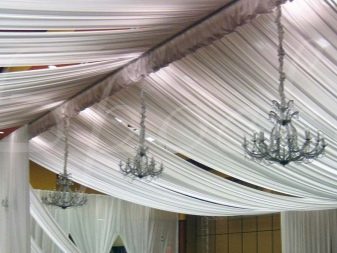
In this case, you can use any smooth, translucent shimmering materials: silk, organza, chiffon and other beautiful fabrics.
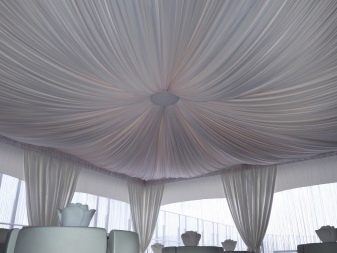
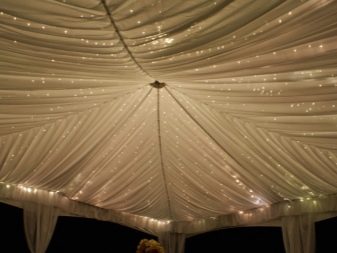
- Wood and its derivatives
There are different ways to integrate wood, as well as materials that successfully imitate it in the decoration of the ceiling area. When installing hemmed systems, lining is used - a natural wooden board, or MDF finishing boards with a veneer, plastic coating or laminated with a PVC film. Their advantages are durability, safety and moisture resistance. Textured variety and a huge range of colors allow you to choose a solution for your needs and budget possibilities.

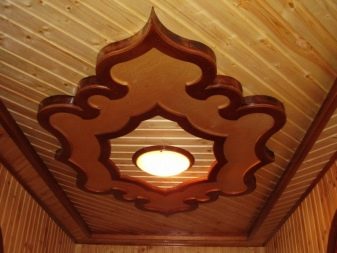
Varieties of wood finishes:
- Solid wood. A coffered ceiling made of solid alder, oak and other types of wood is considered an expensive finish. A distinctive feature of this ceiling is the graceful square recesses. An alternative to an array can be a block house that realistically imitates a tree.
- Bar. Decorating ceilings with timber looks most advantageous in country or country houses, and not in apartments, where a wooden ceiling may seem inappropriate. The timber has the same qualities as the lining, but at the same time it has increased strength characteristics and a longer service life.
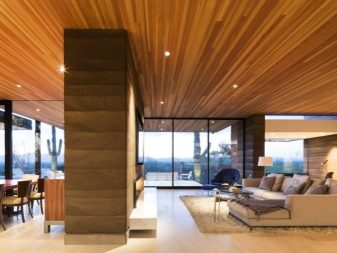
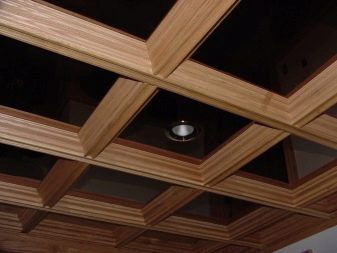
- Laminate. Finishing the ceiling with a laminate certainly cannot be attributed to the traditional methods of decorating the space above your head.Although the use of laminated panels allows you to become the owner of a high-quality, expressive and durable ceiling with excellent soundproofing ability.
- Ceiling beams. Ceiling beams have become an interior classic. When choosing the design of beams in natural performance or painted, the style of the interior serves as a reference point. The same applies to their geometric shape - in the form of rough rough logs, bars with a regular square or rectangular cut.
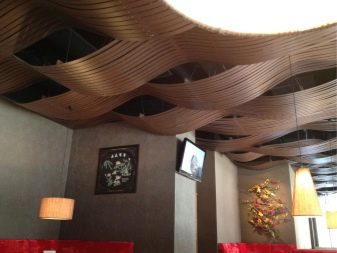
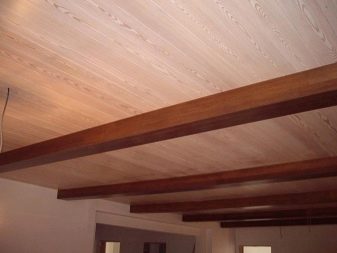
Single-level and multi-level structures
Suspended ceilings are one-, two-, three- and multi-level, in the creation of which certain materials are used.
- Sibling
One-level ceilings are considered to be flat ceilings with a single level of smooth or textured decorative coating without stepping, like in multi-level structures.
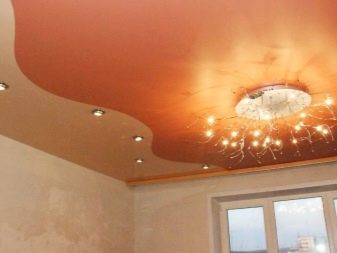
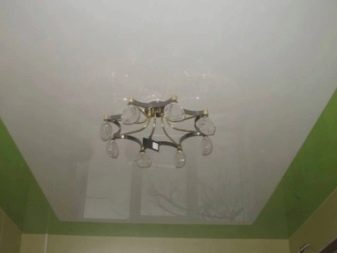
- Two-level
A feature of two-level ceilings is the creation of two elevation marks in one room due to a pronounced step formed by the structure on the ceiling surface. It is convenient to hide engineering communications under the skin, and to mount spotlights in the body of the skin. The disadvantages include the fact that they visually reduce the height of the room and are more expensive than options with one level.

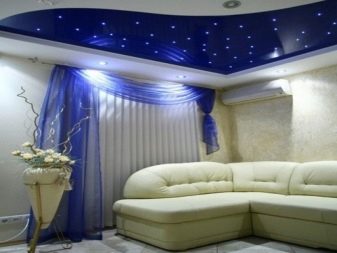
Their form can be absolutely any. The easiest way is to focus on the volume of simple geometric shapes: square, circle, triangle, ellipse. And you can complicate the task by integrating a curved gypsum box with niches for light sources in one part of the ceiling area and installing a stretch canvas in another part. With the help of two-level structures, it is good to perform accent zoning, visually marking the boundaries of functional areas.

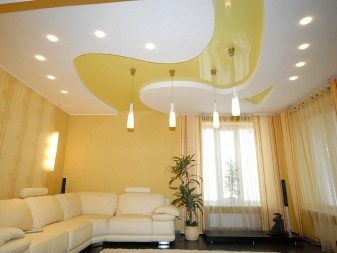
- Multilevel
For the construction of multi-level ceilings in the form of stepped structures with three or more level differences, any modern systems are suitable - hemming, tension or suspended. Very often, architects use combinations of materials using several technologies at once.
The multilevel ceiling provides an opportunity to disguise serious defects of the upper floors (height differences at the joints of reinforced concrete slabs, protruding beams), construction flaws and communications. Such designs of ceilings are distinguished by a variety of architectural forms.
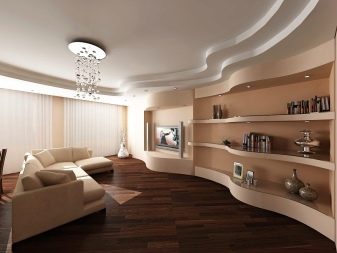
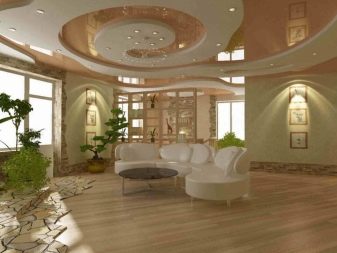
Let us dwell in more detail on the current types of ceiling systems.
- Tensioned
Today, stretch ceilings are one of the most common ways to decorate the lower surface of floors, which is due to their aesthetic appeal and the fact that they have not yet had time to bore the Russians.
Their device involves the use of polyvinyl chloride film or fabric treated with impregnation with polyurethane and a special gas cannon for injecting hot air with a temperature of about 70 ° C, the effect of which ensures the tension of the web. It is supported by a profile pre-assembled along the entire length of the closed contour of the room.
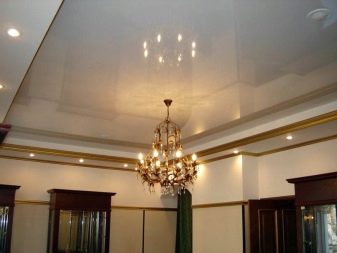
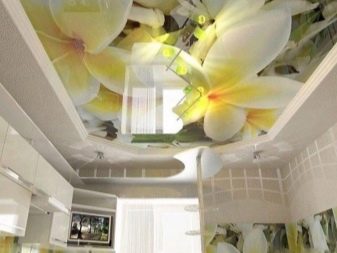
Depending on the texture, they can be:
- Glossy or with a mirrored surface. Such solutions have excellent reflectivity and give the room an illusion of volume.
- Classic matt with discreet colors.
- Satin with a smooth relief, due to which the canvas looks snow-white with a delicate mother-of-pearl tint.
- Suede - fabrics imitating the structure of piled leather.
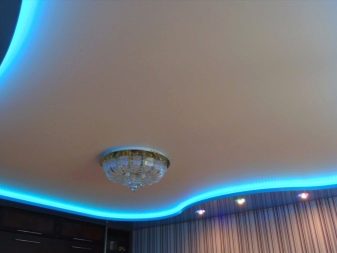
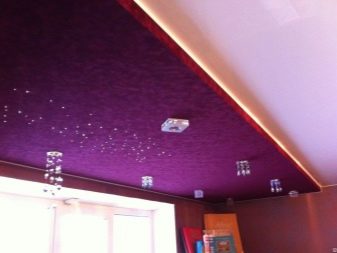
In addition, film coatings differ in design and are:
- With photo printing. The most popular 3D images are sky with clouds and space theme.
- Carved are double Apply tension systems. Their design is a pair of independent tensioning fabrics: the first with figured holes, and the second one-piece.
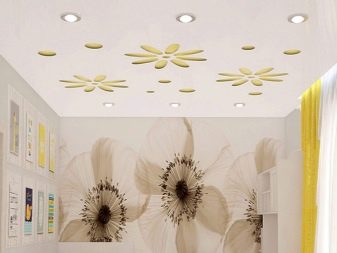
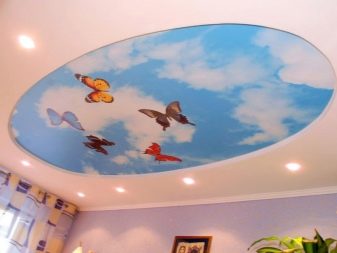
Advantages:
- decorative qualities;
- suitable for installation in any premises;
- sealed;
- clean installation;
- durable.
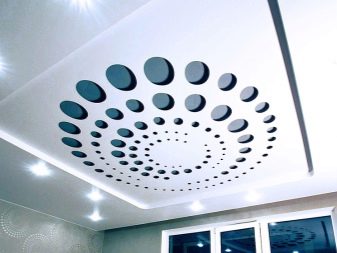

Of the minuses, it is worth noting:
- high cost;
- reducing the height of the walls;
- susceptibility to damage by any sharp objects;
- non-ecological composition.

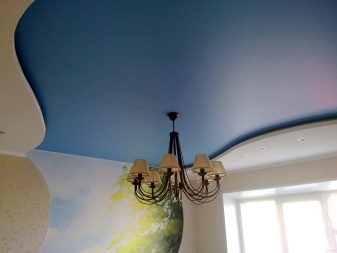
- Cassette suspended
They are prefabricated structures that are mounted at a distance of at least 10 cm from the floors. Such structures are found mainly in offices or public places, since it is rather difficult to integrate them into apartments.
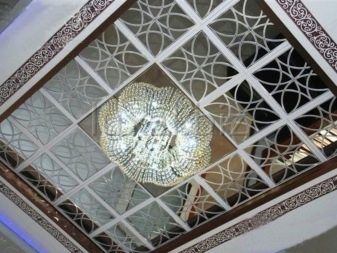
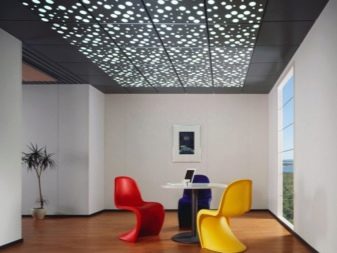
Advantages:
- the ability to mask communications and install various lighting devices;
- cleanliness of the installation process;
- hide defects in the base;
- fireproof due to its refractory properties;
- provide good sound insulation.

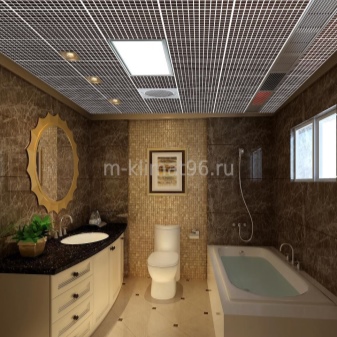
Disadvantages:
- "Eat up" the height;
- time consuming installation of a multilevel ceiling;
- restrictions on use - not suitable for rooms with high humidity conditions.
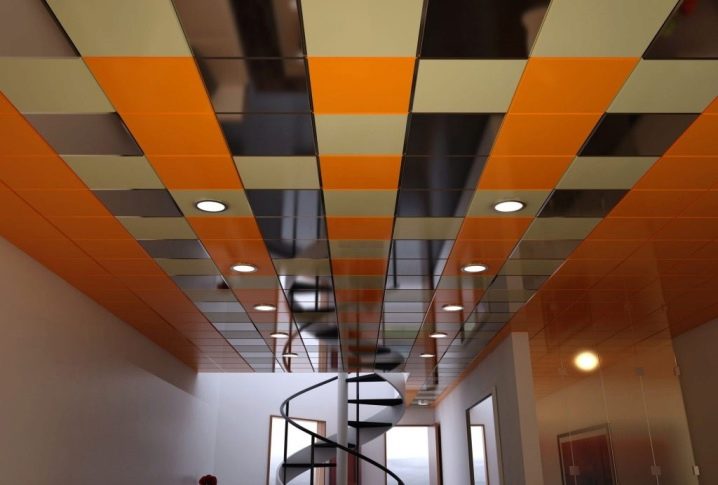
- Rack
They use small slats, which explains the name of this type of ceiling. For the assembly of the frame, metal profiles called "comb" or stringers, U-shaped end plinths located along the walls and special suspensions are used.
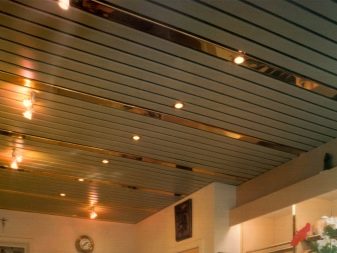
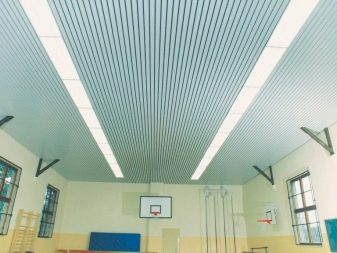
Based on the material of manufacture, they can be:
- plastic, which are recruited from PVC rails;
- metal - in this case, use aluminum or steel chrome-plated or galvanized rails.
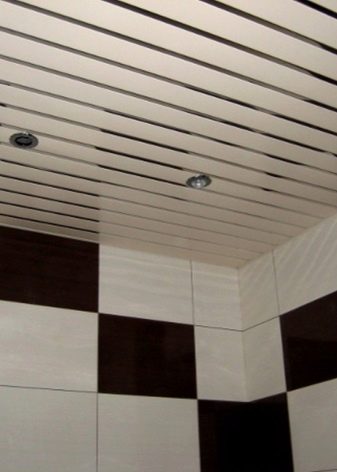

Advantages:
- stylish design;
- masking communications and natural unevenness of the base;
- the ability to install electrical appliances;
- resistance to humid environment and antifungal properties;
- good strength characteristics;
- durable - able to last 25-50 years.

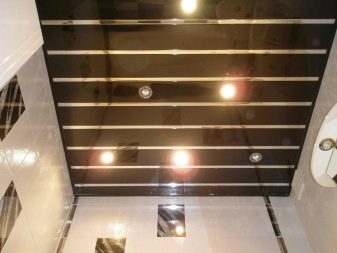
Disadvantages:
- steal the height;
- "cold" blows from them;
- the complexity of dismantling.

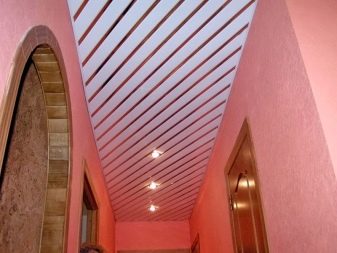
- Plasterboard
It is difficult to imagine modern construction without drywall. This material is an active participant in the organization of suspended ceiling structures.
Advantages of GKL systems:
- allow you to hide any communications;
- provide the opportunity to create an interesting lighting design due to the installation of various types of electrical appliances;
- fireproof, since the core of the gypsum board consists of non-combustible gypsum;
- have good vapor permeability, as drywall is a "breathable" material.
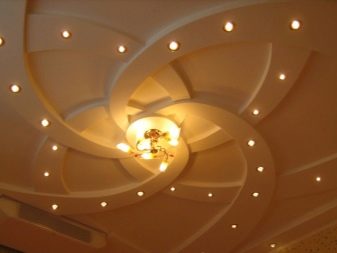
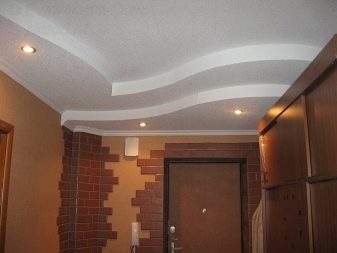
Disadvantages:
- lower the ceiling level at least 10 cm below the floor slab;
- time consuming installation;
- the process of creating a ceiling includes dirty types of work - cutting sheets, sanding, painting.


Design
The ceiling decor allows you to customize the design of the ceiling area, which always favorably distinguishes the interior from hundreds of others, sometimes faceless and very boring precisely because of their uniformity. Beauty has nothing to do with it, it's just that the eye has nothing to cling to in such an environment. Even fashionable "special effects" in the form of 3D drawings do not always save the situation, although this finishing method, of course, should not be neglected either.
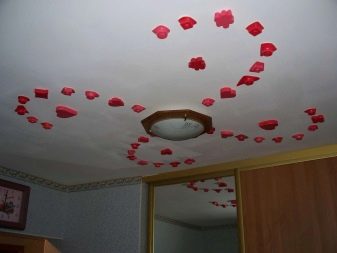

Let's find out what design techniques are in fashion now and where they are best used in order to avoid the unpleasant dissonance of expectations and reality.
- Art painting
The hand-painted ceiling surface looks very beautiful, just remember the magnificent vaulted ceilings with frescoes by the masters of the Renaissance. Such a finish cannot be ignored, especially when a professional artist had a hand in its creation. In this case, only one thing stops - the price of the issue. The services of a master are worth it.
For those who have long been familiar with paints and a brush, it will not be difficult to use any of the art painting techniques and bring it to life. We recommend everyone else to use ready-made stencils, which, by the way, you can make yourself. All that remains is to fix them on the ceiling surface in various combinations with adhesive tape, arm yourself with a brush and paint over.
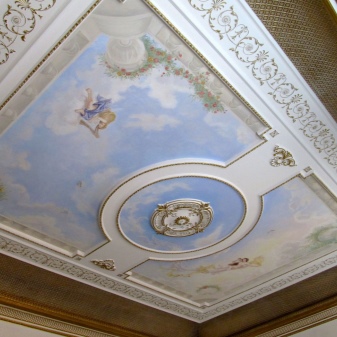
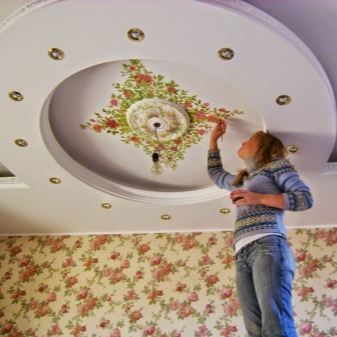
- Vinyl Decal Appliques
This is one of the most democratic, fastest and simplest ways to decorate ceilings.Of course, one cannot count on the aesthetics that ensures the creation of artistic painting. The advantages of such a decor are minimum costs, ease of implementation and ease of masking minor cosmetic defects.
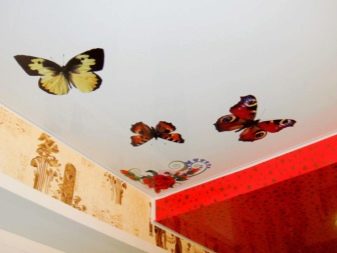

-Stucco molding
This finish is ideal for classic, antique and gothic interiors. A distinctive feature of these styles is stucco ceilings. Polyurethane skirting boards are indispensable for creating its imitation. With the help of other curly elements - rosettes, borders, moldings and cornices, you can achieve the maximum resemblance to the authentic stucco ceilings of the Middle Ages or the times of Ancient Rome.
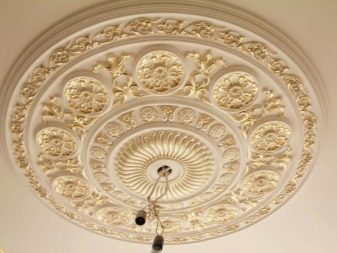
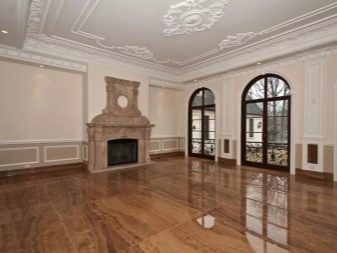
- Decorative cord
The creation of edging with a decorative edging (cord) in the form of a twisted rope is an excellent alternative to fillets. There are no special rules for the use of the cord, but it is most profitable to use the cord on tension and plasterboard structures, since the edging from it provides an ideal masking of technological gaps at the joints of the ceiling with the walls. And also it will evenly lay down on complex rounded and stepped sections of the ceiling.
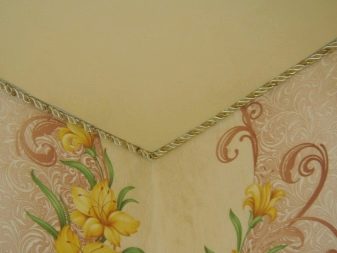
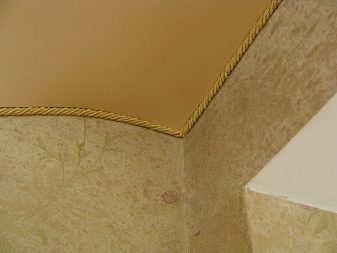
Style
The world of interior design, although it lives by its own unwritten laws, does not have a clear set of rules, which lists the points of what can and cannot be done. The only condition that decorators observe when drawing up an interior is the development of a harmonious design concept that maximally reflects the preferences of the customer and is close to him in spirit and lifestyle. The choice of design for the ceiling area is no exception. We propose to consider the distinctive features of ceilings in different styles.
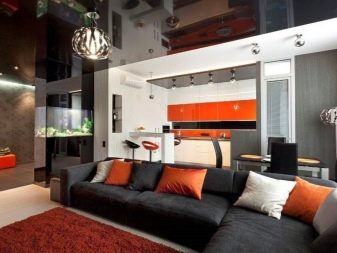
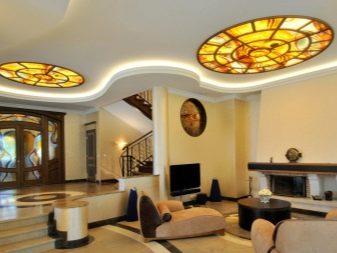
- Modern
The ceilings are characterized by an abundance of arbitrarily curved lines and rounded shapes that seem to flow into each other without clear visual boundaries. This is a design with a predominance of plant motifs and a harmonious arrangement of all elements of the composition. In the decoration, it is allowed to use rough materials, metal, wood, glass.
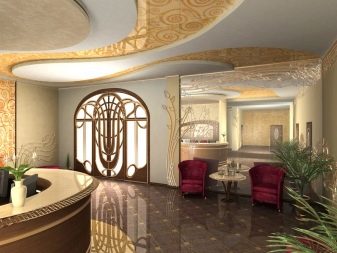
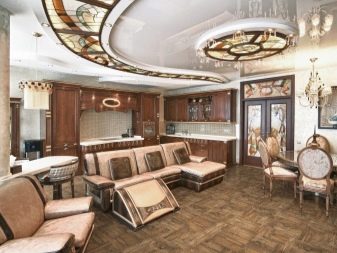
- High tech
In this case, it is not so decorative that is important, but the verified proportions of the ceiling and a well-thought-out lighting system. To create a futuristic atmosphere, Apply luminous ceilings or stretch structures with a glossy or translucent canvas are perfect. In open-plan apartments, multi-level gypsum plasterboard ceilings with a beautiful box, LED backlighting and a balanced color scheme are appropriate.


- French country
To ensure that the ceiling perfectly matches the style that originated in the province of Provence in the south of France, you can resort to the device:
- classic white ceiling with rough texture beams;
- stretch ceiling of a pastel, white or beige shade with a translucent illuminated "window". Such an insert will give the interior lightness and create the effect of weightlessness;
- multilevel stretch ceiling with spotlights along the perimeter of one of the levels.
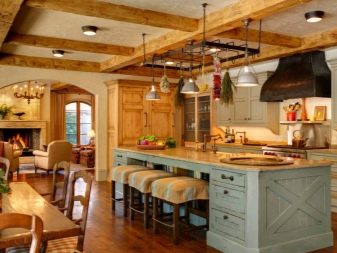
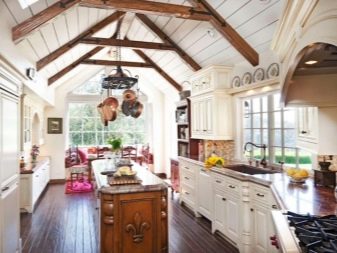
- Classics
If we talk about luxurious classic interiors with elements of pompous palace styles, then you can consider such design options for the ceiling area as a device:
- A two-level white or slightly bluish ceiling with curly stucco elements in the rococo style. Internal lighting is mounted around the perimeter.
- Suspended plasterboard construction in a golden hue with the installation of a two-level sculptural border.
- Three-level suspended coffered openwork ceiling, framed by mirrors.
- Ceiling with a plasterboard overlay insert, decorated with silver vinyl wallpaper.
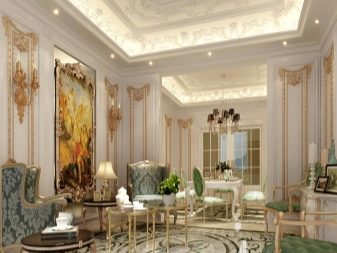
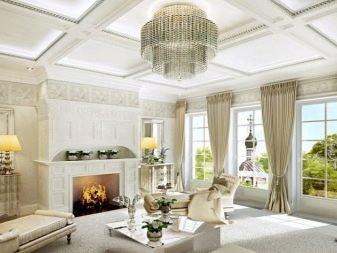
If this is an interior in a modern classic style, then the setting is appropriate here:
- Stretched single-level printed canvas with an abstract pattern in delicate colors. The texture of the film coating is desirable satin with a restrained shine, which perfectly corresponds to the spirit of neoclassicism.
- A two-level stretch fabric with a combined fabric to create an effective contrast between the matte outer layer and the inner glossy one. Gloss will add gloss and volume to the room.
- Stretch ceiling with three-dimensional 3D-pattern or PVC plates with photo printing. It is better to give preference to neutral images: flowers, plants, frescoes, classic paintings.
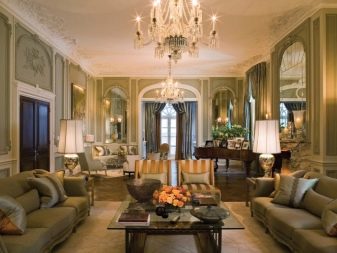
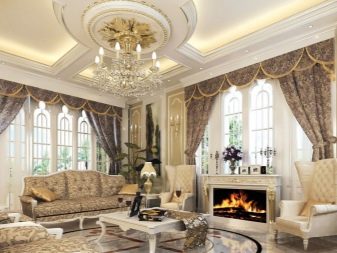
Color spectrum
When choosing a ceiling color, the design and color temperature of the room are always taken into account.
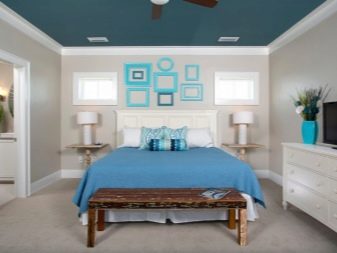
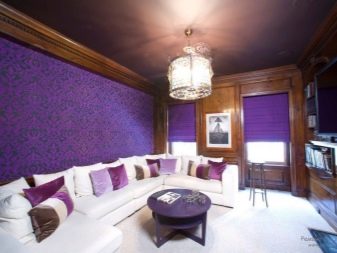
Compliance with the basic principles of color matching allows you to become the owner of a beautiful ceiling:
- If you plan to create a colored ceiling, then the maximum number of shades used is three. An exception is the design using various variations of gradients, that is, smooth color transitions.
- To maintain the color balance in the interior, the ceiling colors should not contradict the general palette and support the shades of the background finish, flooring, furniture and decor.
- When the priority is to use saturated, rich colors on the ceiling, try to use a neutral palette of shades when decorating the walls.
- Dreaming of a two-tone ceiling? Be prepared to take the time to find a winning color combination specifically for your interior. Moreover, even a duet of green and red can turn out to be successful and stylish, and not just the classic contrasting color pair of white and black.
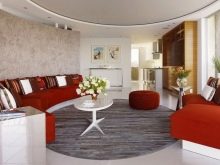
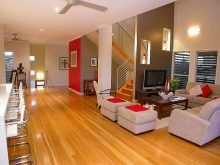
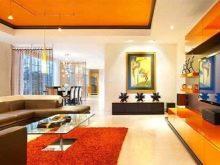
Which is the best to do?
Summarizing all that has been said, we list the varieties of the most suitable solutions for ceiling structures, depending on the functionality of the room, as well as based on practical and aesthetic considerations:
- Living room. Any variation of stretch ceilings, including those made of combined materials, plasterboard systems, coffered ceilings, basic ones with painted plaster finishing, adhesive options as a budget option, are suitable. If the interior of the living room is made in oriental style, then it is worth taking a closer look at the draped ceilings or the option with a smooth, tightly stretched fabric in cases where the design is sustained in the tendencies of French country.
- Bedroom. Here, combined ceilings made of gypsum plasterboard with a satin or matte canvas, both with one level and multi-level, are appropriate. A defiant gloss is good in living rooms, but here you need a more intimate setting, which is facilitated by the elegant shine of satin or a noble matte surface. If the room is spacious and you want something non-trivial, then you should try the original laminate ceiling decoration with a transition to an accent wall.
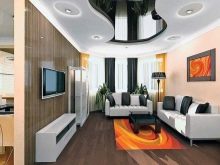
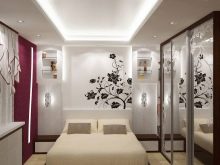
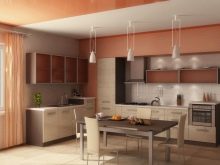
- Kitchen. Stretch structures with a light glossy canvas, when the room is compact, are considered a universal solution. Here you can also use the possibilities of suspended cassette systems if you choose the option with matte white translucent squares in the center. In this case, the overhead lighting is mounted in a technological niche between the floor slab and the ceiling structure, which allows an interesting lighting effect to be achieved.
- Bathroom. Rack type ceilings, single-level or multi-level, provided that the walls are of sufficient height, stretch glossy, are suitable here.
- Attic. When decorating the ceiling area in an attic apartment or drawing up an attic interior in a private house or in the country, it is recommended to use plasterboard, hemming or hanging systems. For finishing the last two options, it is good to use a wooden lining, a beam or its imitation, a parquet board or corrugated board (profiled sheet), larch wood.

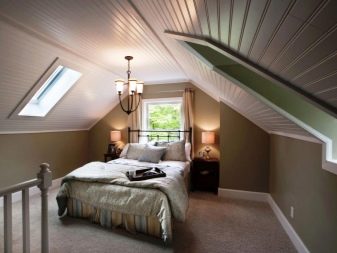
Lighting
The main guideline when choosing light sources and organizing ceiling lighting is the functional load of the room.
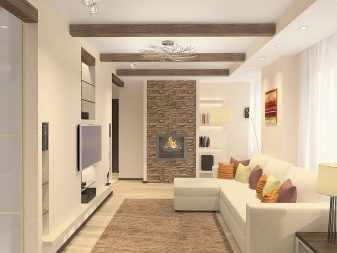
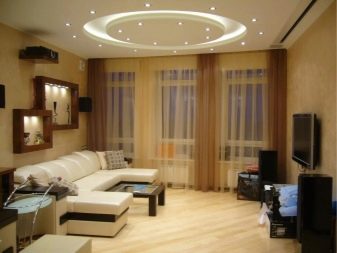
- Living room
Here the task is to create sufficient illumination, close to natural light, it is in such conditions that we experience emotional and psychological comfort, and our eyes rest.Whether a central chandelier is needed here or there are enough local lighting sources will depend on the planning solution and the footage of the room.
In open-plan apartments, it is beneficial to use accent light zoning. So, a chandelier or a composition of lamps on suspensions is placed above the guest area, and diode or spot lighting is made in the remaining functional segments. If the room is very large, then wall or floor lamps are additionally used.
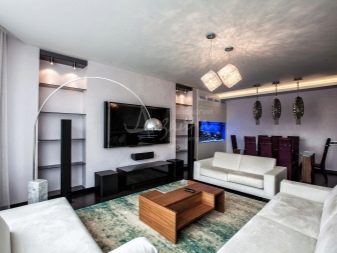
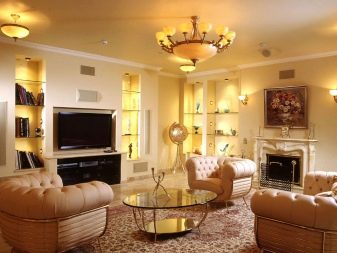
- Bedroom
The main lighting is a central chandelier with soft light, local lighting is ceiling lighting plus a couple of floor lamps or wall sconces. Lighting zoning is a common design technique that also allows you to save on electricity bills if you get a triple switch and illuminate the part of the room that is used at a particular moment.
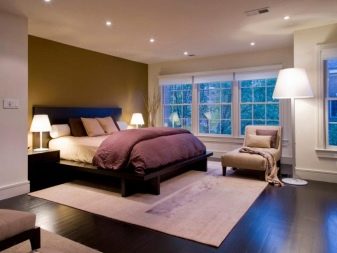
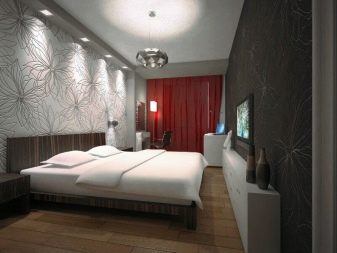
- Kitchen
In this case, you need to remember that the quality of lighting largely depends on the color of the ceiling. Cold shades of the light palette - gradations of blue, white, pale yellow, lamps with a warm color temperature are made neutral. The cold glow of the light bulbs enhances the color of the coating, which will reflect the light rays, coloring the entire “contents” of the kitchen space from objects to ready-made food.
Ideal for those who prefer a dark color scheme - install a variety of LED point lights that create the effect of a starry sky and provide the desired illumination. In kitchens with high ceilings, lamps with an adjustable suspension or elongated lamps look great. For compact rooms with low ceilings, there is nothing better than spotlights on the ceiling in combination with a simple chandelier.
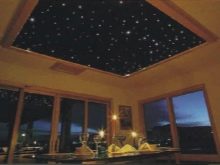
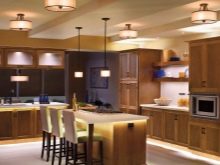

- Bathroom
Since windows in bathrooms are a rather rare occurrence for typical apartments, you have to be content with artificial lighting. Depending on the location, it can be ceiling, floor, wall, built-in. Usually the first two types are enough, when the built-in LED strips are supplemented with floor lamps.
You can use a combination of all options, by all means highlighting the functional areas of the bathroom or shower, sinks and mirrors. It is impossible to imagine modern bathroom lighting design without decorative lighting. This can be flashing or colored contour lighting, lighting with a "starry sky" effect in the ceiling area above the Jacuzzi, etc.

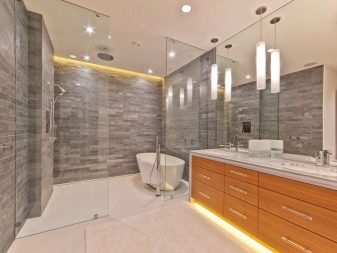
Tips & Tricks
The choice of the ceiling is a responsible business.
We offer several tips that may come in handy in one case or another:
- If you find it difficult to decide on the color of the stretch ceiling, choose one of three classic colors - universal white, elegant beige or black with anthracite. By the way, the neutral beige palette has more than 25 shades.
- When installing a ceiling in a new building, it is necessary to leave a small margin - to make an increased distance between the tension or suspension system and the floor slab. When the building shrinks, the geometry of the ceiling structure will be preserved due to the "spare" centimeters.
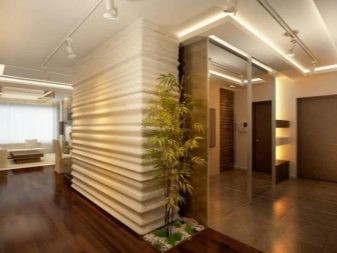
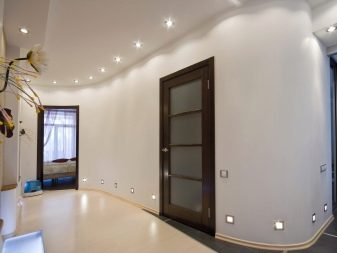
- To decorate the ceiling of a narrow corridor in Khrushchev-built apartments, a mirrored wall and a glossy ceiling with illumination will visually add volume to the room. The simultaneous use of gloss, mirrors and varnished surfaces will create an optical illusion of 3D space.
- If the ceiling is stretch and you plan to install a chandelier, then you need a model with lamps at the bottom of the structure. This will avoid strong overheating of the PVC coating and the release of toxic phenol.
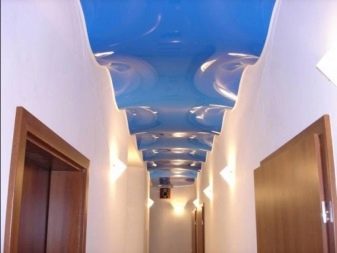
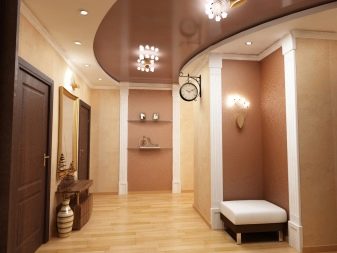
Manufacturers
In connection with the increased interest in stretch and rack ceilings, a stream of fakes poured into the market. In order not to fall for the bait of unscrupulous competitors of reputable manufacturers, always check quality certificates and try to deal only with trusted companies.We recommend that you pay attention to four brands that hold leading positions in the ceiling construction market.
"Bard"
If you are looking for a high-quality slatted aluminum or steel ceiling, then look at suspension systems with a protective moisture-resistant dust-repellent coating. The variety of panel colors and interpanel inserts makes it easy to choose the right ceiling model for any interior solution.
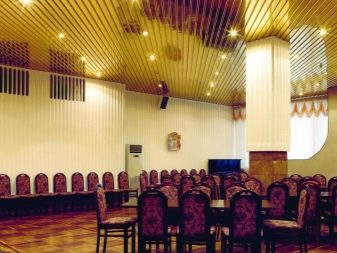
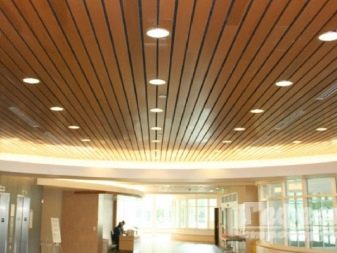
Apply
The emergence of Apply carved ceiling systems has changed the conventional concept of stretch ceilings. With Apply systems, the implementation of the most unusual design projects has become more accessible, simple and convenient. The trouble-free and quick installation of light art canvases opened up new possibilities in the lighting design of living spaces. And when installing the ceiling, you can use a simplified version of the supply ventilation system. Another non-standard solution from Apply is a two-tier structure in an original contrasting design.
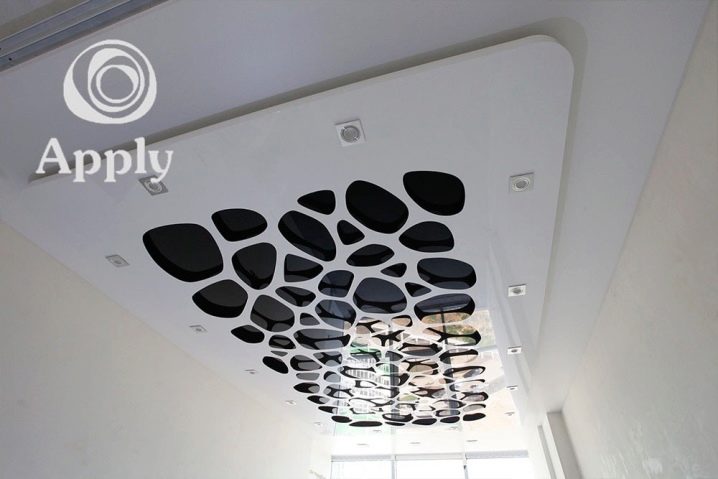
"Calypso"
One of the advantageous properties of woven stretch ceilings from this company is the use of seamless fabric for their production. Unlike foil coverings with a maximum width of 2 m, a standard roll of fabric ceiling is 5 m wide, so its installation does not require soldering the structural elements. The manufacturer offers a variety of color, stylistic, functional solutions for tension structures, which simplifies the search for "your" stretch ceiling.
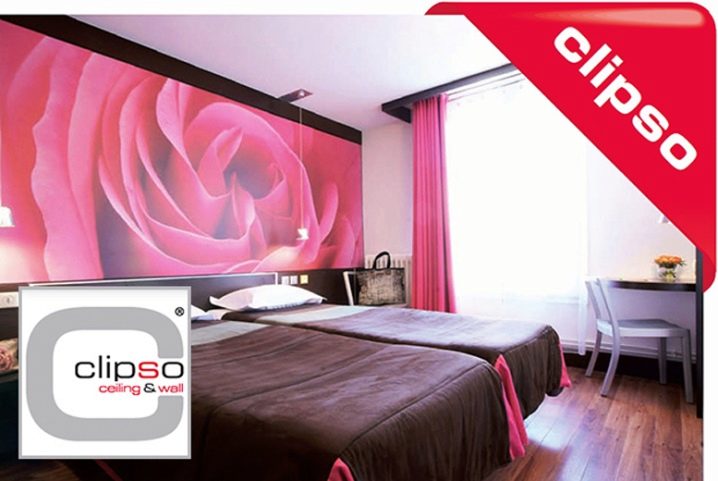
Cesal
Under this brand, a variety of types of modern ceiling systems are produced: cassette, rack and pinion, "Grilyato" from classic to multicellular. Those who are preoccupied with finding an original ceiling option should pay attention to design models in the Scandinavian and Canadian styles. Modular systems are ideal for the implementation of the most daring architectural solutions. Such an opportunity is provided by profiles of different sizes, which are convenient to combine when decorating the ceiling space, and due to a single system of fasteners, installation is also as convenient as possible.

Beautiful examples in the interior
The ceiling surface is a platform for the implementation of a variety of design projects from simple to super complex, which solve many stylistic and planning tasks. We offer several inspiring ideas for decorating ceiling spaces in various styles and photo examples of integrating different types of ceilings into the interiors of apartments and private houses.

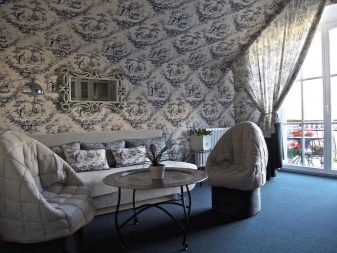
The unabated interest in stretch ceilings is largely due to the huge color palette of film materials. In addition to basic shades, there are many other universal color schemes. Blue and blue ceilings, shocking reds and greens, which always refresh the interior, look very interesting.
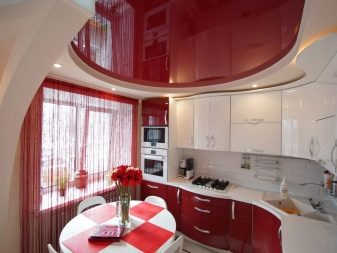
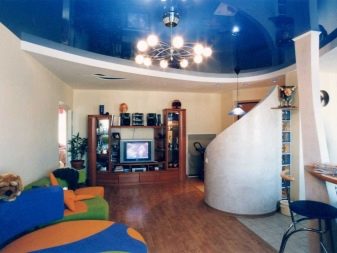
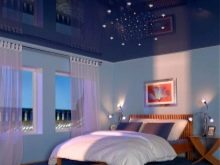
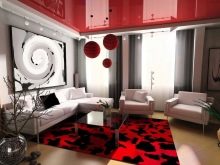
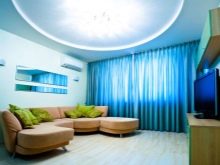
A combined finish is an opportunity to play on the color and texture contrast of different materials. One such solution is to create a transition from the accent wall to the central part of the ceiling. It turns out a kind of "island", which acts as an element of accent zoning, focusing attention on a specific functional area.
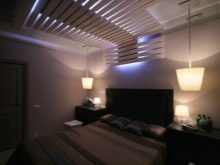
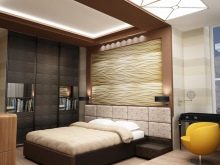

Draperies on the ceiling are appropriate in those rooms where it is important to create a cozy and inviting atmosphere. These are living rooms, of course, bedrooms, children's rooms, as well as open verandas.
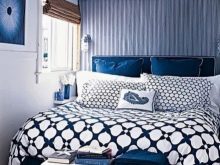
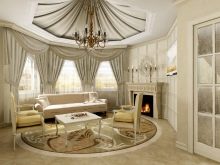
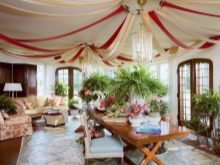
Tiered ceilings with gilded stucco décor, sculptural borders, draperies, mirrors or coffered slabs and built-in niches for cascading teardrop chandeliers create a Baroque, Rococo or Empire style ambiance.
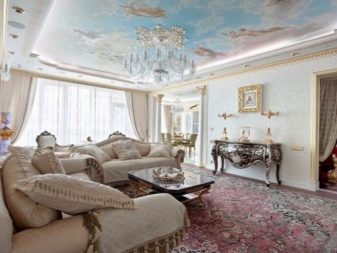
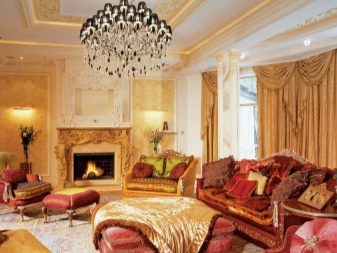
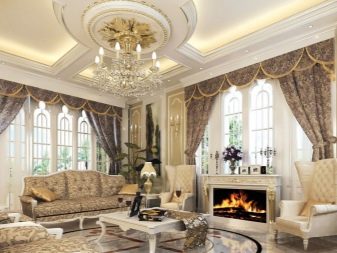
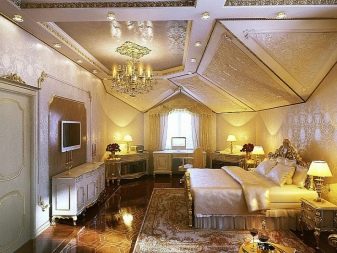
The ceilings "starry sky" are very beautiful, and if the "stars" have a twinkling effect, then it is doubly beautiful. It is not known how long the aesthetic pleasure of contemplating the mysteriously sparkling space overhead in one's own home lasts and the feeling of novelty remains, but this shining splendor will definitely impress guests and, most likely, even cause secret envy.



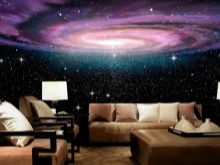

Which ceiling is better to choose and what to look for, see the video below.













The comment was sent successfully.